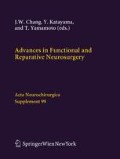Summary
Introduction. The term “camptocormia” describes a forward-flexed posture. It is a condition characterized by severe frontal flexion of the trunk. Recently, camptocormia has been regarded as a form of abdominal segmental dystonia. Deep brain stimulation (DBS) is a promising therapeutic approach to various types of movement disorders. The authors report the neurological effects of DBS to the bilateral globus pallidum (GPi) in three cases of disabling camptocormia.
Methods. Of the 36 patients with dystonia, three had symptoms similar to that of camptocormia, and all of these patients underwent GPi-DBS. The site of DBS electrode placement was verified by magnetic resonance imaging (MRI). The Burke Fahn and Marsden dystonia rating scale (BFMDRS) was employed to evaluate the severity of dystonic symptoms preoperatively and postoperatively.
Results. Significant functional improvement following GPi-DBS was noted in the majority of dystonia cases. At a follow-up observation after more than six months, the overall improvement rate was 71.2 ± 27.0%, in all dystonia cases who underwent the GPi-DBS. In contrast, the improvement rate of the three camptocormia cases was 92.2 ± 5.3%. It was confirmed that the improvement rate for camptocormia was much higher than for other types of dystonia.
Conclusion. According to our experience, a patient with a forward-bent dystonic posture indicative of camptocormia is a good candidate for GPi-DBS. The findings of this study add further support to GPi-DBS as an effective treatment for dystonia, and provide the information on predictors of a good outcome.
Access this chapter
Tax calculation will be finalised at checkout
Purchases are for personal use only
Preview
Unable to display preview. Download preview PDF.
References
Coubes P, Roubertie A, Vayssiere N, Hemm S, Echenne B (2000) Treatment of DYT1-generalised dystonia by stimulation of the internal globus pallidus. Lancet 355: 2220–2221
Coubes P, Cif L, El Fertit H, Hemm S, Vayssiere N, Serrat S, Picot MC, Tuffery S, Claustres M, Echenne B, Frerebeau P (2004) Electrical stimulation of the globus pallidus internus in patients with primary generalized dystonia: long-term results. J Neurosurg 101: 189–194
Eltahawy HA, Saint-Cyr J, Giladi N, Lang AE, Lozano AM (2004) Primary dystonia is more responsive than secondary dystonia to pallidal interventions: outcome after pallidotomy or pallidal deep brain stimulation. Neurosurgery 54: 613–619
Hurst AF (1918) The bent back of soldiers. Br Med J 2: 621–623
Karbowski K (1999) The old and the new camptocormia. Spine 24: 1494–1498
Katayama Y, Kasai M, Oshima H, Fukaya C, Yamamoto T, Ogawa K, Mizutani T (2001) Subthalamic nucleus stimulation for Parkinson disease: benefits observed in levodopa-intolerant patients. J Neurosurg 95: 213–221
Katayama Y, Fukaya C, Kobayashi K, Oshima H, Yamamoto T (2003) Chronic stimulation of the globus pallidus internus for control of primary generalized dystonia. Acta Neurochir [Suppl] 87: 125–128
Nandi D, Parkin S, Scott R, Winter JL, Joint C, Gregory R, Stein J, Aziz TZ (2002) Camptocormia treated with bilateral pallidal stimulation. J Neurosurg 97: 461–466
Sandler SA (1945) Camptocormia: a functional condition of the back in neurotic soldiers. War Med 8: 36–45
Souques A (1915) Contractures ou pseudo-contractures hysterotraumatiques. Rev Neurol 28: 430–431
Zorzi G, Marras C, Nardocci N, Franzini A, Chiapparini L, Maccagnano E, Angelini L, Caldiroli D, Broggi G (2005) Stimulation of the globus pallidus internus for childhood-onset dystonia. Mov Disord 20: 1194–1200
Author information
Authors and Affiliations
Corresponding author
Editor information
Editors and Affiliations
Rights and permissions
Copyright information
© 2006 Springer-Verlag
About this chapter
Cite this chapter
Fukaya, C. et al. (2006). Pallidal high-frequency deep brain stimulation for camptocormia: an experience of three cases. In: Chang, J.W., Katayama, Y., Yamamoto, T. (eds) Advances in Functional and Reparative Neurosurgery. Acta Neurochirurgica Supplementum, vol 99. Springer, Vienna. https://doi.org/10.1007/978-3-211-35205-2_4
Download citation
DOI: https://doi.org/10.1007/978-3-211-35205-2_4
Publisher Name: Springer, Vienna
Print ISBN: 978-3-211-35204-5
Online ISBN: 978-3-211-35205-2
eBook Packages: MedicineMedicine (R0)

